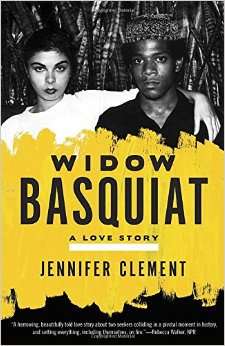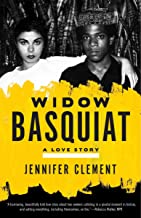Widow Basquiat: A Love Story by Jennifer Clement
Here’s the truth: I don’t know what makes an artist, an artist. They just seem to have this inner-fire pushing them to create. I constantly struggle with what to actually call it. I don’t even know if it has a name; I just know that when people have it they really have it. Only a few people come to mind when I think of art, artists or artistry, as I recognize it to be. And one of those people is Jean-Michel Basquiat.
 Jennifer Clement, author of Widow Basquiat: A Love Story (Crown Publishing, 2014), writes about Basquiat’s life before he became a famous artist. Sadly, he only witnessed his own fame for a short period of time before dying of a drug overdose at 27. Clement, who also serves as the president of PEN International, brilliantly humanizes the immortal street artist as she gives us a glimpse into Basquiat’s personal life, especially how he treated his friends, lovers and rivals.
Jennifer Clement, author of Widow Basquiat: A Love Story (Crown Publishing, 2014), writes about Basquiat’s life before he became a famous artist. Sadly, he only witnessed his own fame for a short period of time before dying of a drug overdose at 27. Clement, who also serves as the president of PEN International, brilliantly humanizes the immortal street artist as she gives us a glimpse into Basquiat’s personal life, especially how he treated his friends, lovers and rivals.
Since I continue to grapple with what exactly defines an artist, BookTrib asked Clement, as part of our ‘One Question and Answer’ series, to explain to us how to define the values that make up an artist. Here’s what she said:
Question: Basquiat has been put on an artistic pedestal and since his death has become a larger than life cultural icon. However, in Widow Basquiat you peel back those layers brought on by time and mystique, both from Basquiat and those closest to him, to find a brilliant, yet deeply troubled individual. Given all of that, can you tell us what quality you find most valuable in an artist, or any creative person for that matter?
Jennifer Clement: I respect craft and intellectual rigor. The current trend where anyone can be an artist is something to be questioned. It can occur, but it’s rare. It did happen to Jean-Michel Basquiat – he had no craft. He had intellectual curiosity, but he did not have diligence.
The Argentine writer Jorge Luis Borges is one of my favorite poets because he was an intellectual. In his verses, one can see his brilliant mind at work and admire genius – the genie.
After the attributes of craft and intellectual understanding of one’s art, which I see as a foundation, I search for courage and rage in someone’s work. Basquiat, of course, overflowed with these. His paintbrushes, paint sticks or little-kid-crayons were swords, daggers and knives. Rage can also be found in humor and Baquiat’s work is filled with irony and wit.
What troubles me today is this bizarre conduct in academia and other forums to protect a reader, or the public of other arts, from materials that might disturb or offend. An artist should be disturbed and confused and in search of what makes us human. This trend makes me think that, instead of art and ideas, courage and debate, rage and daring we’re in a world of fear, cowardice and boredom.
Under the entrance archways of universities, museums and libraries, should we hand out baby blankets, pacifiers and bottles of warm milk?
The Welsh poet Dylan Thomas composed a poem where he speaks to his old and infirm father.
He wrote, “Do not go gentle into that good night, Old age should burn and rave at close of day; Rage, rage against the dying of the light.”
An artist should fight against this dying of the light. An artist should be asking the ancient disturbing, courageous questions, and asking God, with rage or prayer, “Where are You?”
In all great art, I find the search for truth and solace before the invisible. I want mystery and contradiction. I want to not understand.
Buy this Book!
Amazon




